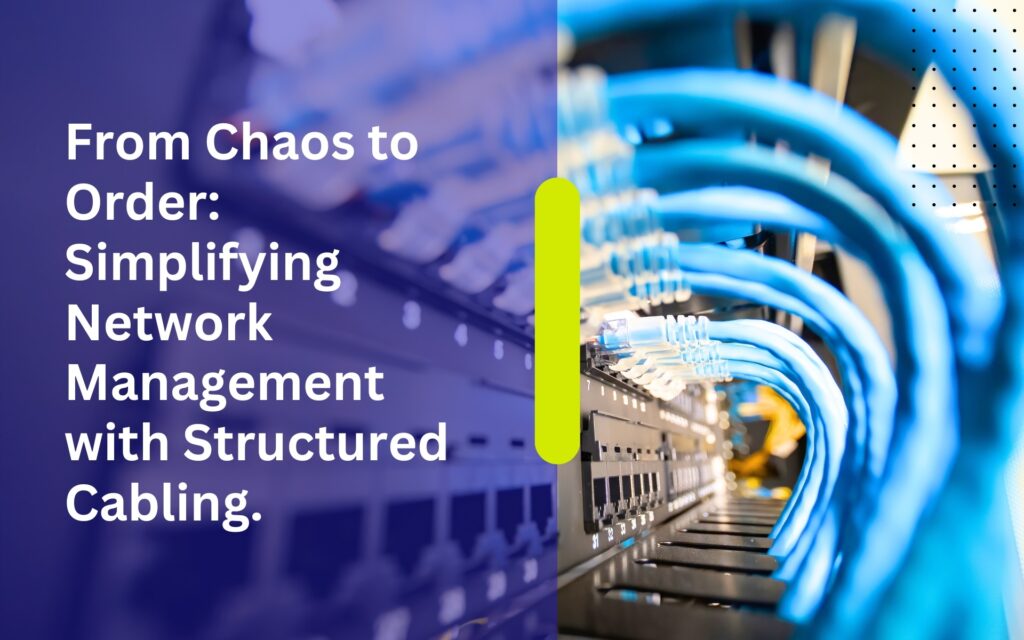Celebrating a Year of Growth and Success at InstallersPH IT Solutions. Introduction. As the year comes to a close, InstallersPH IT Solutions takes a moment to reflect on a journey defined by …
From Chaos to Order: Simplifying Network Management with Structured Cabling.

Introduction
In the ever-evolving landscape of modern business, characterized by rapid technological advancements and dynamic market demands, the need for efficient network infrastructure has become paramount. As organizations strive to remain competitive and agile in an increasingly digitalized world, the expansion of their operations and the embracement of digital transformation initiatives have become imperative. This evolution necessitates a corresponding enhancement in networking capabilities, driving the demand for reliable and scalable networking solutions to unprecedented heights.
Amidst this dynamic landscape, structured cabling has emerged as a foundational element in establishing robust network architectures that can effectively support the evolving needs of modern businesses. Structured cabling represents a systematic approach to network infrastructure design and implementation, providing a framework that aligns with industry standards and best practices. By adhering to established guidelines such as TIA/EIA-568 and ISO/IEC 11801, structured cabling ensures consistency, compatibility, and reliability across diverse network components and environments.
In this article, we delve into the significance of structured cabling as a transformative force in the realm of network management. By examining its role in transitioning chaotic network environments into organized and efficient systems, we uncover the multifaceted benefits that structured cabling brings to businesses of all sizes and industries. From enhancing network performance and reliability to facilitating seamless scalability and future-proofing, structured cabling serves as a linchpin in the architecture of modern networking infrastructures.
Structured cabling not only addresses the immediate challenges of managing complex networks but also lays the groundwork for long-term sustainability and growth. Its systematic approach to cable management, labeling, and documentation simplifies network administration tasks, reducing the risk of errors and minimizing downtime. Additionally, structured cabling promotes efficient airflow and cooling within network environments, optimizing the performance and longevity of networking equipment.
Furthermore, structured cabling empowers organizations to adapt and evolve in response to emerging technologies and changing business requirements. By providing a flexible and scalable foundation, structured cabling enables seamless integration of new technologies, expansion of network infrastructure, and support for evolving connectivity demands. Whether it’s the adoption of IoT devices, the implementation of high-speed data transmission, or the integration of multimedia applications, structured cabling ensures that businesses can embrace innovation without compromising on network performance or reliability.
The Challenge of Chaos in Network Management
In the absence of structured cabling, network management can quickly devolve into a chaotic ordeal of unprecedented proportions. Disorganized cabling not only hampers the scalability of the network but also transforms routine maintenance and troubleshooting tasks into daunting endeavors. Picture a scenario where cables snake haphazardly across server rooms, weaving intricate webs of confusion and frustration. In such an environment, attempting to trace a cable or identify its intended destination becomes akin to navigating a labyrinth blindfolded.
Moreover, the absence of proper labeling exacerbates the situation, turning what should be a straightforward process into a convoluted puzzle. Imagine grappling with a tangled mass of cables, each indistinguishable from the next, with no clear indication of their origins or destinations. In such chaos, even the simplest of tasks, such as making a connection or replacing a faulty component, can escalate into time-consuming odysseys fraught with uncertainty and risk.
The repercussions of such disarray extend far beyond mere inconvenience, with tangible impacts on productivity, efficiency, and the bottom line. Downtime becomes an ever-looming specter, as IT personnel struggle to untangle the mess and restore order to the network. With every passing minute of downtime, the organization hemorrhages revenue and incurs opportunity costs, further exacerbating the financial toll of network mismanagement.
Furthermore, the lack of structured cabling introduces significant risks to network security and data integrity. In a chaotic environment where cables sprawl unchecked, unauthorized access becomes a distinct possibility, as rogue actors exploit the confusion to infiltrate sensitive systems or intercept critical data. Without proper documentation and oversight, identifying and mitigating security threats becomes a Herculean task, leaving the organization vulnerable to breaches and cyberattacks.
In essence, the absence of structured cabling transforms the network infrastructure into a ticking time bomb, primed to detonate at the slightest provocation. Without the guiding principles of organization, standardization, and efficiency that structured cabling provides, organizations find themselves adrift in a sea of uncertainty, grappling with the consequences of their own neglect. In an era where digital resilience is paramount, structured cabling stands as the bulwark against chaos, offering a lifeline to organizations seeking to navigate the tumultuous waters of modern network management.
Structured Cabling: The Foundation of Order
Structured cabling provides a systematic approach to network infrastructure design and implementation. Unlike traditional point-to-point cabling systems, structured cabling organizes network connectivity into a unified and standardized framework. This framework typically consists of distinct subsystems, including horizontal cabling, vertical cabling, and telecommunications rooms, all interconnected through patch panels and distribution racks.
By adhering to industry standards such as TIA/EIA-568 and ISO/IEC 11801, structured cabling ensures consistency and compatibility across different network components and vendors. This standardization not only simplifies installation and maintenance but also lays the groundwork for future scalability and flexibility.
Streamlining Network Management
One of the primary benefits of structured cabling lies in its remarkable ability to streamline network management processes to an unprecedented degree. Through the implementation of clearly defined pathways and meticulously organized labeling schemes, structured cabling empowers IT personnel to navigate the intricate web of connections with unparalleled efficiency and precision. Gone are the days of painstakingly tracing cables through a tangled labyrinth; with structured cabling, technicians can swiftly pinpoint, modify, or troubleshoot connections without disrupting the entire network ecosystem.
This streamlined approach represents a paradigm shift in network administration, significantly reducing the risk of human error and minimizing downtime in the process. By providing a cohesive framework for managing network infrastructure, structured cabling ensures that even the most complex tasks can be executed with ease and confidence. Whether it’s reconfiguring network settings, upgrading equipment, or troubleshooting connectivity issues, the clarity and organization afforded by structured cabling empower IT teams to operate at peak efficiency, driving productivity and enhancing overall system reliability.
Moreover, structured cabling goes beyond mere organization to facilitate efficient cable management, addressing a longstanding challenge that has plagued traditional cabling systems. By leveraging cable trays, racks, and enclosures, structured cabling provides a structured and purpose-built environment for storing cables, free from the clutter and chaos that often characterize conventional setups. This not only reduces the risk of cable damage and signal interference but also enhances the aesthetic appeal of the network environment.
The benefits of efficient cable management extend beyond aesthetics, however, with tangible improvements in airflow and cooling efficiency that contribute to the longevity of networking equipment. By minimizing cable congestion and optimizing airflow pathways, structured cabling ensures that networking devices remain operating within optimal temperature ranges, reducing the risk of overheating and prolonging their operational lifespan. This not only enhances equipment reliability but also reduces energy consumption and associated costs, aligning with sustainability initiatives and environmental stewardship efforts.
In essence, structured cabling represents a holistic approach to network infrastructure design, combining meticulous organization with practical considerations to deliver a solution that is as functional as it is efficient. By streamlining network management processes and facilitating efficient cable management, structured cabling empowers organizations to unlock new levels of productivity, reliability, and sustainability in their network operations. As businesses continue to navigate the complexities of the digital landscape, structured cabling stands as a beacon of order and efficiency, guiding them towards a future of seamless connectivity and uninterrupted innovation.
Ensuring Performance and Reliability
In addition to simplifying network management, structured cabling serves as the cornerstone of ensuring optimal performance and reliability across network infrastructures of all scales. Through adherence to stringent installation practices and meticulous cable management techniques, structured cabling mitigates the risk of signal degradation and electromagnetic interference, safeguarding the integrity of data transmissions even in the most demanding environments.
Structured cabling achieves this feat by implementing standardized cable types, connectors, and termination methods, minimizing impedance variations and signal losses that can occur with disparate cabling approaches. Moreover, by carefully organizing cables and maintaining separation between power and data cables, structured cabling reduces the likelihood of electromagnetic interference, ensuring that critical data remains immune to external disturbances.
Furthermore, structured cabling not only upholds the reliability of existing network infrastructure but also paves the way for the seamless integration of advanced networking technologies. Leveraging the robust foundation provided by structured cabling, organizations can embrace cutting-edge solutions such as Gigabit Ethernet, Power over Ethernet (PoE), and fiber optics with confidence, knowing that their infrastructure is capable of supporting the demands of these technologies.
Gigabit Ethernet, for example, harnesses the high-speed capabilities of structured cabling to deliver blazing-fast data transfer rates, enabling organizations to meet the burgeoning bandwidth requirements of modern applications and services. Similarly, Power over Ethernet (PoE) utilizes structured cabling to deliver both data and power over a single Ethernet cable, simplifying deployment and reducing infrastructure costs for devices such as IP cameras, wireless access points, and IoT sensors.
Moreover, the adoption of fiber optics, facilitated by structured cabling, opens up new possibilities for high-speed connectivity and long-distance transmission. By harnessing the superior bandwidth and immunity to electromagnetic interference offered by fiber optic cables, organizations can future-proof their networks against evolving bandwidth requirements and emerging technologies, ensuring scalability and resilience in the face of uncertainty.
In essence, structured cabling not only ensures the present reliability and performance of network infrastructure but also lays the groundwork for future innovation and growth. By prioritizing standardized practices, meticulous cable management, and compatibility with advanced technologies, structured cabling empowers organizations to build agile, future-ready networks that can adapt to the evolving demands of the digital landscape. As businesses continue to push the boundaries of connectivity and innovation, structured cabling remains an indispensable enabler of progress, delivering the stability, performance, and scalability needed to thrive in an ever-changing world.
Future-Proofing the Network
As businesses continue to evolve and embrace emerging technologies, the scalability of the network infrastructure becomes increasingly important. Structured cabling offers a future-proof solution by providing a flexible and adaptable framework that can accommodate evolving business needs and technological advancements.
By designing the structured cabling system with scalability in mind, organizations can easily expand their network infrastructure without the need for extensive reconfiguration or downtime. Whether it’s adding new workstations, upgrading equipment, or integrating IoT devices, structured cabling ensures seamless integration and interoperability, allowing businesses to stay agile and competitive in a rapidly changing landscape.
Conclusion
From chaos to order, structured cabling serves as the cornerstone of efficient network management. By providing a systematic and standardized approach to infrastructure design and implementation, structured cabling simplifies network administration, enhances performance and reliability, and future-proofs the network for tomorrow’s challenges. As businesses continue to rely on robust and scalable networking solutions, structured cabling remains indispensable in building resilient and adaptable network architectures. Embracing structured cabling is not just about organizing cables; it’s about laying the foundation for a more connected, efficient, and agile future.
Related Articles
Notice to the Public: Holiday Vacation Advisory of InstallersPH IT Solutions. Introduction. InstallersPH IT Solutions is committed to providing reliable and professional IT services to all our valued clients and partners. As …
The On-the-Job Training Experience of Sherlyn Linao. Introduction On-the-Job Training (OJT) is an essential part of a student’s academic development, providing practical exposure to real workplace environments. It allows interns to apply …



